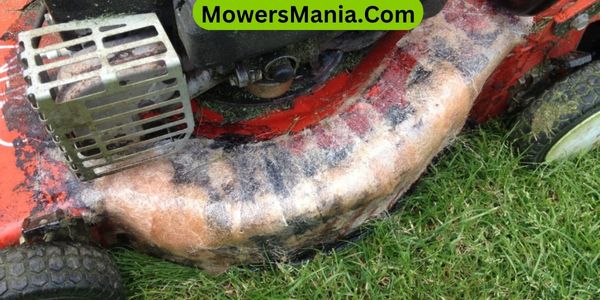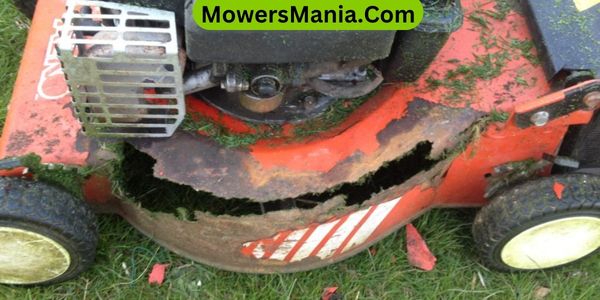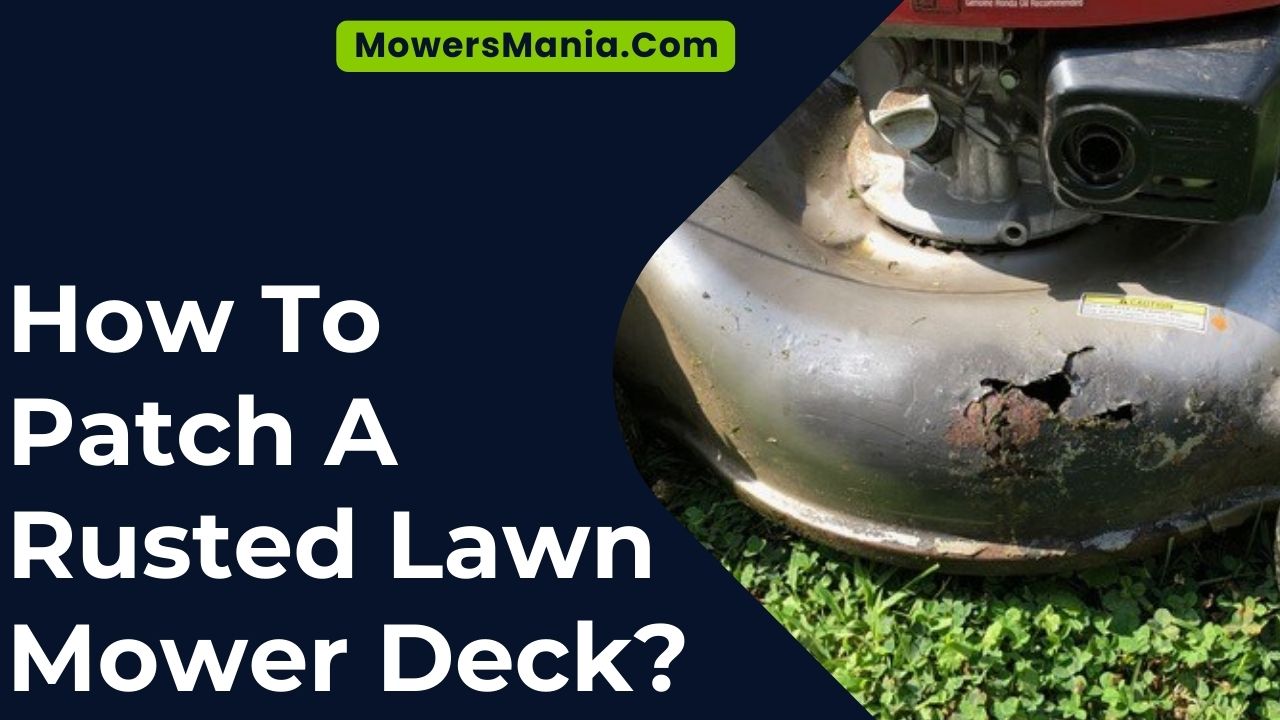So, you’ve let your lawn mower deck rust to the point where it looks like it’s auditioning for a role in a post-apocalyptic movie.
Don’t worry, patching up that rusty mess is easier than you think. With a few basic tools and a bit of elbow grease, you’ll have your mower deck looking good as new in no time.

Just follow these simple steps and you’ll be back to mowing your lawn in style.
Assessing the Rust Damage
To begin assessing the rust damage on your lawn mower deck, start by carefully inspecting the affected areas for signs of corrosion and weakened metal.
Use a wire brush to remove any loose rust and dirt. Pay close attention to the areas around the bolts, edges, and corners where rust tends to accumulate.
Once the loose rust is removed, use a metal pick or screwdriver to probe the affected areas. If the metal feels soft or crumbly, it indicates advanced rust damage and may require patching or replacement.
Next, examine the underside of the deck. Check for any perforations or holes caused by rust. These can weaken the structural integrity of the deck and may need immediate attention to prevent further damage.
Additionally, inspect the welds and seams for signs of rust and deterioration. Address any weak spots promptly to avoid potential safety hazards during operation.
Gathering the Necessary Tools
Now it’s time to gather the necessary tools for the job. You’ll need essential repair tools like a wire brush, sandpaper, and a putty knife.
In addition, gathering materials such as rust converter, primer, and metal patch will be crucial for the patching process.
Essential Repair Tools
You’ll need to gather all the necessary tools for patching a rusted lawn mower deck before you begin the repair process.
The essential tools include safety goggles, gloves, a wire brush, sandpaper, a metal patch or mesh, rust converter, primer, and metal paint.
Safety goggles are crucial to protect your eyes from debris, and gloves will shield your hands from sharp edges and chemicals.
A wire brush and sandpaper will help you remove the rust and prepare the surface for patching.
The metal patch or mesh, rust converter, primer, and metal paint are essential for reinforcing the patched area and preventing future rust.
Ensure you have all these tools on hand before you start the repair to make the process smoother and more efficient.
Gathering Materials and Tools
Ensure all the essential tools are gathered before beginning the repair process. These tools include safety goggles, gloves, a wire brush, sandpaper, a metal patch or mesh, rust converter, primer, and metal paint.
The wire brush will help in removing loose rust and paint, while sandpaper will smooth out the rough spots.
The metal patch or mesh will be used to cover the rusted area, and the rust converter will stop the rusting process and prepare the surface for painting.
Additionally, the primer will help the paint adhere better, and the metal paint will provide a protective coating.
With these tools and materials at hand, you’ll be well-prepared to effectively patch the rusted lawn mower deck.
Preparing the Mower Deck Surface

To effectively prepare the mower deck surface for patching, start by thoroughly cleaning off any dirt, grass clippings, and debris.
Use a wire brush or scraper to remove any loose rust or paint. Once the loose debris is removed, wash the deck with a mixture of mild detergent and water.
Scrub the surface with a scrub brush or a sponge to ensure all the dirt and grime are removed. After washing, rinse the deck with clean water and allow it to dry completely.
Next, carefully inspect the deck for any remaining rust or damage. Use sandpaper to smooth out any rough spots or remaining rust.
Pay close attention to the edges of the damaged area to ensure a smooth transition between the old metal and the new patch.
If there are any holes or deep rust spots, consider using a rust converter to treat the affected areas before applying the patch.
Applying Rust Converter
Start by applying the rust converter to the affected areas of the mower deck to effectively treat and neutralize any remaining rust. This will help to stop the corrosion process and prepare the surface for patching.
Follow these steps to apply the rust converter:
- Prepare the Surface: Thoroughly clean the affected areas of the mower deck to remove any loose rust, dirt, and debris. Use a wire brush or sandpaper to roughen the surface for better adhesion of the rust converter.
- Apply the Rust Converter: Use a paintbrush or roller to apply the rust converter evenly onto the affected areas. Ensure complete coverage and allow it to penetrate the rust for the specified time according to the product instructions.
- Allow for Drying Time: After applying the rust converter, allow it to dry completely. The drying time may vary depending on the product used, so refer to the manufacturer’s recommendations. Once dry, the rust converter will have transformed the rust into a stable, black protective coating ready for further repair.
Following these steps will effectively treat the rust and provide a suitable foundation for patching the mower deck.
Patching the Rust Spots
To start patching the rust spots on your lawn mower deck, first, choose the right patch material that suits the size and severity of the rust.
After that, prepare the rusted area by removing any loose rust and cleaning the surface thoroughly.
Once the area is prepped, apply the patch carefully and securely to ensure a smooth and durable finish.
Choosing Patch Material
You’ll need to gather a suitable patch material for repairing the rust spots on your lawn mower deck.
Here are a few options to consider:
- Metal Patch Panels: These are durable and can be welded or riveted onto the rusted areas for a long-lasting repair.
- Fiberglass Cloth and Resin: This lightweight option is great for smaller rust spots and can be molded to fit the contours of the deck.
- Rust Converter and Patching Compound: Use a rust converter to treat the rusted areas and then apply a patching compound designed specifically for metal repairs.
Choose a patch material based on the size and severity of the rust spots, as well as your skill level and the tools available to you.
Preparing the Rusted Area
Once you have selected the appropriate patch material for the rusted areas on your lawn mower deck, the next step is to prepare the surfaces for patching.
Start by cleaning the rusted areas thoroughly with a wire brush to remove any loose rust, dirt, and debris. This will ensure a clean and smooth surface for the patch material to adhere to.
After cleaning, use a fine-grit sandpaper to roughen the surface around the rust spots. This helps the patch material bond better with the metal.
Wipe the area clean with a damp cloth to remove any remaining dust or particles. Ensure that the surface is completely dry before applying the patch material.
Preparing the rusted area properly is crucial for a successful patch job and long-lasting results.
Applying the Patch
After preparing the rusted areas, you’ll be applying the patch material to the lawn mower deck to effectively cover and repair the rust spots.
Here’s how to do it:
- Clean the area: Use a wire brush to remove any remaining loose rust or debris from the surface. Wipe it down with a clean cloth to ensure the area is free from dirt and dust.
- Apply the patch: Cut the patch material to fit the size of the rusted spots. Use a putty knife to press the patch firmly onto the affected areas. Ensure that the patch is smooth and flat against the deck.
- Let it dry: Allow the patch material to dry completely according to the manufacturer’s instructions before sanding it down to create a seamless finish.
Finishing and Protecting the Deck

To protect the newly patched rusted lawn mower deck, apply a rust-resistant primer. This will help to prevent future rusting and provide a smooth surface for the topcoat.
Once the primer has dried, you can apply a rust-inhibiting paint specifically designed for outdoor metal surfaces. This will further protect the deck from corrosion and provide a clean, finished look.
| Step | Description |
|---|---|
| 1 | Clean the deck thoroughly |
| 2 | Apply rust-resistant primer |
| 3 | Allow primer to dry |
| 4 | Apply rust-inhibiting paint |
Cleaning the deck ensures that the primer and paint adhere properly. Use a wire brush or sandpaper to remove any remaining rust or loose paint. Once the deck is clean, follow the manufacturer’s instructions for applying the primer and paint.
Typically, this involves using even strokes and allowing adequate drying time between coats. Once the paint has dried completely, the lawn mower deck will be protected from rust and corrosion, extending its lifespan and maintaining its appearance.
Frequently Asked Questions [FAQs]
Can I Use a Different Type of Rust Converter if I Can’t Find the Recommended One?
If you can’t find the recommended rust converter, it’s best to stick to the type specified for your lawn mower deck. Using a different type may not provide the same level of protection or compatibility.
What Should I Do if I Accidentally Apply Too Much Rust Converter to the Mower Deck Surface?
If you accidentally apply too much rust converter to the mower deck surface, wipe off the excess with a clean cloth. Be careful not to spread it to unaffected areas. If necessary, lightly sand the area to remove any excess.
Is It Necessary to Remove All the Rust Before Patching the Rust Spots, or Can I Just Patch Over It?
You should remove as much rust as possible before patching. If you just patch over it, the rust will continue to spread underneath the patch, leading to more damage. Properly prepping the surface ensures a longer-lasting fix.
How Long Should I Wait Before Using the Lawn Mower After Applying the Rust Converter and Patching the Rust Spots?
After applying the rust converter and patching the rust spots on your lawn mower deck, wait at least 24 hours before using the mower. This allows the converter and patch to properly adhere and dry, ensuring effective rust prevention and a smooth mowing experience.
Will the Patching Material Hold up Against Regular Use and Exposure to Outdoor Elements?
Yes, the patching material will hold up against regular use and exposure to outdoor elements. It’s designed to withstand tough conditions and provide long-lasting protection for your lawn mower deck, ensuring durability and reliability.
Conclusion
Now that you have patched the rust on your lawn mower deck, your mower will be ready to tackle the grass with ease.
Remember to keep an eye on any future rust spots and address them promptly to prolong the life of your mower.
With the right tools and techniques, you can keep your equipment in top shape for years to come.
Happy mowing!



